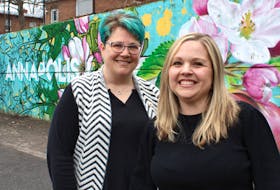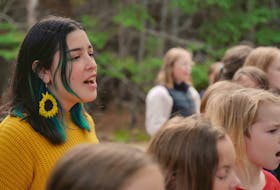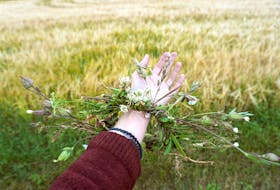NORTH SYDNEY — Sifting through the wrack line at Pottle Lake, Elizabeth Jessome seems delighted when she discovers a collection of mussel shells buried in various grasses, sticks and other debris along the shore.
“This is a midden,” explains Jessome, a project specialist with ACAP Cape Breton, as she continues to uncover mounting evidence of a muskrat meal. “You can see there’s a lot of washup from the waves and the weather but there was quite a few ... I wonder if we kind of excavate. Look, see? So at some point there was someone hanging out having some good snacks here.”

Standing a few metres away, ACAP project manager Jen Cooper adds that the little pile of shells a muskrat leaves behind after its lunch is also a useful way for scientists — or anyone else who’s interested — to meet some of the creatures that live under the surface of the lake.
“They’re nice for us, for observation biologists, because you’re able to see what species there are in the lake without having to go into the lake.”
Sights and sounds

As an ecologist and educator, Jessome says her favourite thing is taking people into nature and introducing them to the plants and animals — like muskrats and mussels — that live there. Now, because of the COVID-19 pandemic, she’s finding ways to bring nature to them.
So, she and Cooper have been out in the field, taking photos, shooting videos and recording bird calls so ACAP can help people learn about the woods, watersheds and wetlands around the Cape Breton Regional Municipality at a time when it can’t host its regular guided walks or take students on field trips.
“Normally, one of ACAP’s goals is to get people of all ages outside, into nature, and connect them with nature in some way. We’re taking lots of pictures, we’re recording some videos. We’re going to try to get some sounds of birds,” Jessome said after filming a pair of ducks in one of the many vernal pools — shallow, temporary bodies of water — that surround many lakes.
“Some people may have never visited the forest, or this particular forest, and they may never have thought about who would use the pools in the forest. Everyone’s experience is different, everyone’s interest is different, so one of the ideas we had is something as simple as taking a video of animals in the environment in action and just asking people what they see — identify this — and then they can learn about American black ducks, which is what these were. They’re also an important habitat for salamanders and frogs and that sort of thing.”

Say ‘cheeseburger’
A couple hundred metres farther along the pathways that wind the wetland, Jessome and Cooper pause to listen to a bird call out. It’s a black-capped chickadee, a familiar forest species and frequent backyard visitor, but it’s not the sound you might expect to hear.
"chick-a-dee-dee-dee"
“If you’ve ever heard a chickadee sing, of course it goes ‘chick-a-dee-dee-dee,’ but it also says ‘cheeseburger,’ and kids love that, they think it’s really funny,” said Jessome, who points out another of the many bumblebees that have been buzzing around the forest that day.

“One thing that you might not think about is that trees are food for pollinators. So in the spring, red maples, different willows and poplar trees, they put out their flowers early and we’ve seen a lot of bees today who are probably feeding on the forest flowers.”

Stop and look
Later, Jessome pauses to record a video of a tree trunk, slowly panning her smartphone along the trunk to see what insects and bugs might be hanging out. Sure enough, a firefly crawls along a thin branch before it spreads its wings and flies off.

The lesson: if you take the time to stop and look around, you might be surprised by what you see.
“Looking at a tree trunk or the forest floor through a lens, or at least with your eye up close, you notice so many things that you wouldn’t notice otherwise just walking through,” she said. “It’s teaching people to slow down and observe. And that firefly is a perfect example of that because if you’re sitting in one spot, chances are you’re going to see a spider or a bee or a fly, or some kind of forest-dwelling animal, or hear a bird.”
While Jessome isn’t sure how the pandemic will impact ACAP’s community outreach programs in coming months, she says they want to continue collecting materials — such as photos, videos and audio recordings — so they can be ready to share them with the public.
“We’re trying to find ways to bring nature into homes,” she said. “We can’t bring people into nature with us, so we’re trying to find ways to engage their senses so we can deliver those same sorts of experiences.”

The cry of the loon.








